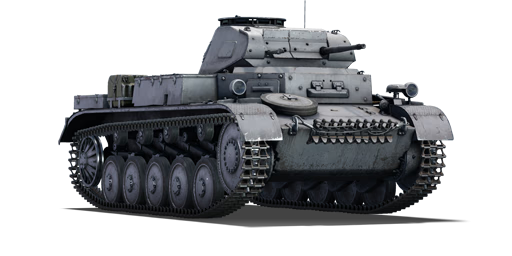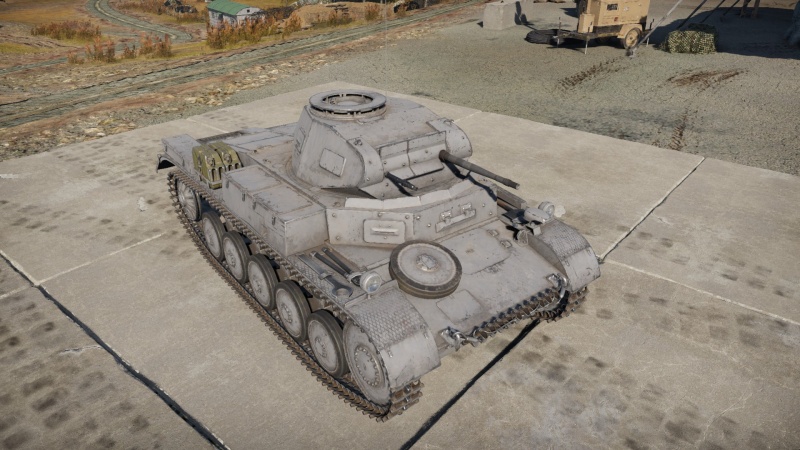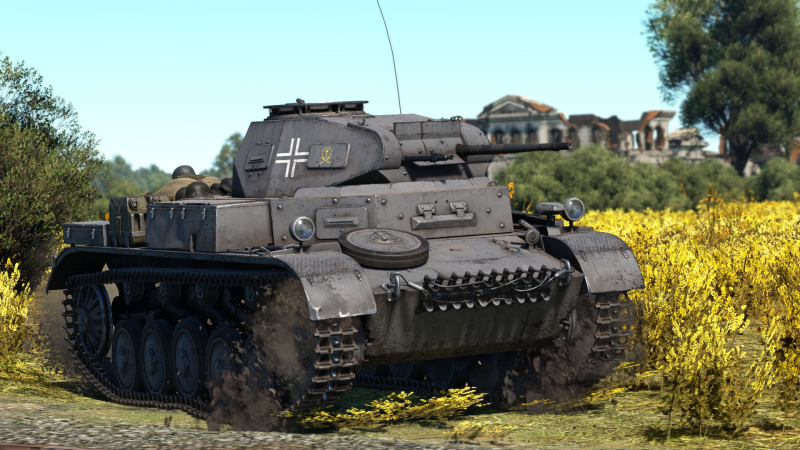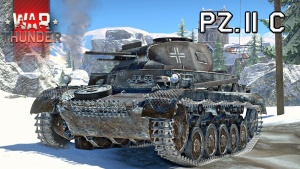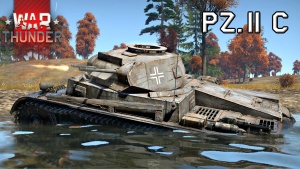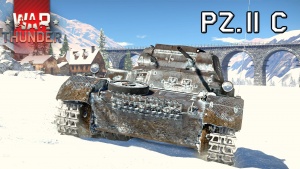Pz.II C
| This page is about the German light tank Pz.II C. For other versions, see Pz.II (Disambiguation). |
Contents
Description
The Panzerkampfwagen II Ausführung C (Panzer II C) (Sd.Kfz. Index: Sd.Kfz. 121) is the third variant of the Panzer II light tank family. Both the Panzer I and II light tank families were seen as interim solutions until the introduction of advanced tanks, particularly the Panzer III and IV medium tank families. Despite this, Panzer IIs remained in duty throughout World War II, serving as the principal light tank in German service and as a scout, despite the fact that many wheeled vehicles performed this specialized task significantly better. The Panzer II light tank family's origins may be traced back to 1934 when the Waffenamt (military ordnance agency) realized that difficulties in the manufacturing of the Panzer III and IV medium tanks necessitated the development of a new design that could rapidly replace the outdated Panzer I light tanks. The accepted design was essentially an expanded Panzer I with a turret mounting the new Rheinmetall Kampfwagenkanone (KwK) 30 L/55 20 mm autocannon. The armament was based on a 20 mm Flugabwehrkanone (Flak) 30 anti-aircraft autocannon with a fire rate of 600 rpm. As the Spanish Civil War demonstrated, a significant increase in armour was required, and the early variants of Panzer II had integral 14 mm (0.55 in) homogeneous steel armour (10 mm/0.39 in top and bottom), which was adequate against shrapnel and small bullets. It was, however, vulnerable to several high-velocity anti-tank guns at the period. The Panzer II C variant was ordered to keep the factories working until the Panzer III and Panzer IV medium tanks could be mass-produced. The only noticeable difference between Panzer II variants A, B and C is a new enhanced vision port and slight improvements in crew protection. To keep the 50 mm bulletproof glass in place, it had two conical beaded bolts on the face plate and two huge bolts above and below it. It retained a 20 mm KwK30 L/55 autocannon capable of firing armour-piercing (AP) and high-explosive (HE) ammunition. In 1940, more armour was added to the tank's hull and turret. In 1941, the commander's cupola was installed. The addition of armour to the front hull glacis plates transformed the hull's appearance from a curved frontal armoured hull to an angular shape.
Introduced in the Closed Beta Test for Ground Forces before Update 1.41, the Panzer II C is one of the few light tanks available to the German Army during World War II. The German Army's ground forces are mostly made up of medium tanks, heavy tanks, and tank destroyers. Later in the conflict, light tanks were rarely constructed because armoured-wheeled vehicles performed similar duties but considerably more efficiently. In general, in the hands of a skilled player, the Panzer II C is a dangerous light tank. Since most enemy tanks in the early ranks are fairly poorly armoured, the Panzer II C may unleash a wave of armour-piercing shells down the adversary path with the KwK30 L/55 20 mm autocannon, crippling most opponent tanks with a single ammunition clip.
General info
Survivability and armour
The Pz.II C has (on the surface) decent frontal armour, with 35 mm for the front plate with a section of heavily sloped 30 mm armour on the glacis, then a sloped lower glacis that has 35 mm as well. The side, rear, and hull roof armour are a paltry 15 mm, including the turret sides. The front turret face is 30 mm that do not overlap with the 30 mm thick gun mantlet well so it will be rare, if not impossible, for a chance at relying on a 60 mm overlapping area to deflect rounds.
Generally speaking, the Pz.II C does not have enough armour to defend itself unless fighting from an extreme range (which most early-ranked tanks can't reasonably do well), facing SPAA vehicles that are only using high-explosive shells or facing against some early-ranked French tanks.
Put shortly - do everything to ensure that the Pz.II C does not get hit, because even one well placed shot in the crew compartment will likely knock the Pz.II C out.
Armour type:
- Rolled homogeneous armour
| Armour | Front (Slope angle) | Sides | Rear | Roof |
|---|---|---|---|---|
| Hull | 20 + 14.5 mm (6°) Upper plate 14.5 mm (74°) Upper glacis 20 mm (33°) Lower glacis |
14.5 mm | 14.5 mm (6°) Upper plates 10 mm (61°) Lower glacis |
14.5 mm (16°) Front glacis 15 mm Crew compartment 14.5 mm Rear 10 mm (9°) Engine access panel 5 mm Vents |
| Turret | 20 + 14.5 mm (cylindrical) Turret front 14.5 + 14.5 mm (cylindrical) Gun mantlet |
14.5 mm (21°) | 15 mm (24°) | 10 mm (15°) Front 10 mm Rear |
| Cupola | 15 mm (cylindrical) | 10 mm | ||
Notes:
- Suspension wheels and torsion bars are 10 mm thick while tracks are 15 mm thick.
- Mudguards are 4 mm thick.
- Belly armour is 5 mm thick.
Mobility
| Game Mode | Max Speed (km/h) | Weight (tons) | Engine power (horsepower) | Power-to-weight ratio (hp/ton) | |||
|---|---|---|---|---|---|---|---|
| Forward | Reverse | Stock | Upgraded | Stock | Upgraded | ||
| Arcade | 49 | 10 | 9.1 | 217 | 267 | 23.85 | 29.34 |
| Realistic | 44 | 9 | 124 | 140 | 13.63 | 15.38 | |
Mobility-wise, the Pz.II C is actually better than most of its peers, but the BT series tanks and M3 Stuarts will still outpace it quite easily. Regardless, the Pz.II C can get around the battlefield quite respectably, and the vehicle's power-to-weight ratio makes it easy to go up steep inclines than larger, heavier vehicles. However, the Pz.II C is not going to outrun a pursuing enemy team, so locating good cover is immensely useful for its survival.
Modifications and economy
Armaments
Main armament
The main armament of the Pz.II C is the 20 mm KwK30 automatic cannon.
With the ability to load HVAP rounds capable of penetrating 48 mm at point blank range, combined with its magazine-loaded rapid fire, the 20 mm can puncture through most enemy armour at this battle rating range like it is fabric.
The biggest problem with the 20 mm autocannon is the 10 round magazines combined with a 7.8s stock reload time, meaning that the tank may successfully take out two or three enemy tanks with controlled bursts, but is likely to be taken out during the reload. Another problem to consider is in the powerful HVAP ammunition, in that its impressive penetration statistics can make the gun reach out to about 200-300 m, but the penetrative power drops off rapidly after that due to velocity drop, even more so than the standard PzGr round.
| 20 mm KwK30 | Turret rotation speed (°/s) | Reloading rate (seconds) | ||||||||||||
|---|---|---|---|---|---|---|---|---|---|---|---|---|---|---|
| Mode | Capacity (Belt) | Fire rate | Vertical | Horizontal | Stabilizer | Stock | Upgraded | Full | Expert | Aced | Stock | Full | Expert | Aced |
| Arcade | 180 (10) | 280 | -9°/+20° | ±180° | Vertical | 13.33 | 18.45 | 22.40 | 24.77 | 26.35 | 7.80 | 6.90 | 6.36 | 6.00 |
| Realistic | 8.33 | 9.80 | 11.90 | 13.16 | 14.00 | |||||||||
Ammunition
- Default: API-T · HEFI-T* - The belt composition means that 50% of the shells (HEFI-T*) are useless against tanks. However, this belt is reliable against open-topped or thin-skinned vehicles like SPAA vehicles. Since there are no dedicated high-explosive shells for the selection, having one belt of this in reserve does not hurt for those situations.
- PzGr: API-T - This belt offers a good transition from the Default to the PzGr 40 belt. The round offers decent damage against lightly armoured tanks, especially at close range. Due to lack of high-explosive filler, however, it is better to focus on the PzGr 40 belt to maximize penetration power.
- PzGr 40: HVAP-T - Probably the best belt with the best penetrating shell for the vehicle. While the damage effects post-penetration can be quite poor, the rapid fire from the autocannon can mitigate this problem by following up quickly with another penetrating shot. In close combat, these shells should be used against modules and crew member to make the most of each shell. Against angled armour, however, the HVAP ammo may not be very effective. Unlike the Flakpanzer 1 and Flakpanzer 38, this belt is still 100% HVAP.
| Penetration statistics | |||||||
|---|---|---|---|---|---|---|---|
| Ammunition | Penetration @ 0° Angle of Attack (mm) | ||||||
| 10 m | 100 m | 500 m | 1,000 m | 1,500 m | 2,000 m | ||
| HEFI-T* | 5 | 4 | 3 | 2 | 2 | 2 | |
| API-T | 37 | 34 | 23 | 14 | 9 | 6 | |
| HVAP-T | 48 | 45 | 31 | 20 | 13 | 8 | |
| Shell details | ||||||||||||
|---|---|---|---|---|---|---|---|---|---|---|---|---|
| Ammunition | Velocity (m/s) |
Projectile mass (kg) |
Fuse delay (m) |
Fuse sensitivity (mm) |
Explosive mass (TNT equivalent) (g) |
Ricochet | ||||||
| 0% | 50% | 100% | ||||||||||
| HEFI-T* | 900 | 0.12 | 0.1 | 0.1 | 10.2 | 79° | 80° | 81° | ||||
| API-T | 800 | 0.15 | - | - | - | 47° | 60° | 65° | ||||
| HVAP-T | 1,050 | 0.1 | - | - | - | 66° | 70° | 72° | ||||
Ammo racks
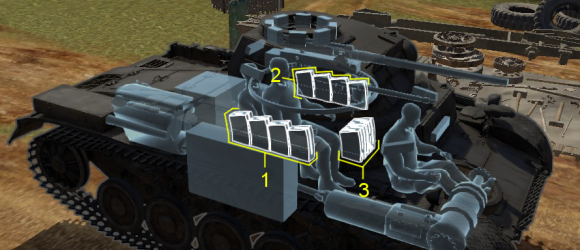
| Full ammo |
1st rack empty |
2nd rack empty |
3rd rack empty |
Visual discrepancy |
|---|---|---|---|---|
| 18 | 11 (+7) | 7 (+11) | 1 (+17) | No |
Notes:
- Ammunition is modeled as 18 magazines of 10 rounds.
- Racks disappear after you've fired all magazines in the rack.
- Right flank empty: 11 (+7) magazines.
Machine guns
Mounted opposite to the 20 mm autocannon is the MG34, which is loaded with a 50-round belt with an AP-I/AP-I/AP-T ammo pattern. With 13 mm of maximum penetration at point blank range, this gun's 800 RPM rate of fire will make short work of unarmoured vehicles like truck-based SPAA, as well as exposed enemy crew members.
| 7.92 mm MG34 | ||||
|---|---|---|---|---|
| Mount | Capacity (Belt) | Fire rate | Vertical | Horizontal |
| Coaxial | 1,800 (150) | 900 | N/A | N/A |
Usage in battles
The main key to success with this vehicle is to drive aggressively, trying to take shots at relatively close range (100-300 m or even less). Aim for the enemy's weak spots such as modules and crew members. Go for flank or rear shots in order to make the most of the 20 mm close-range penetration power on the enemy's thinner armour plates.
When positioning the Pz.II C, try to use the terrain to remain hull down so that a quick reverse can mask the hull. With this position, the Pz.II C can quickly scoot forward and fire off a few quick shots before reversing to a safe position away from enemy fire. Keep this in mind when attempting to ambush the enemy in an open arena with little cover, as cover and concealment are more reliable in disrupting enemy return fire accuracy than the Pz.II's thin armour.
Alternatively, the Pz.II C can be played as a support vehicle, a second line tank, to say the least, to assist more armoured allies when pushing the cap. Use short bursts (2-4 rounds ideally) to disable enemy vehicles by targeting weak points like their transmission or turret crew, then use the remaining ammo to take out the rest of the enemy crew, or let friendly tankers take them out for assists. The Pz.II C lacks the mobility to disengage and run from tanks like the M3 Stuarts or BT series tanks, but if their transmission, driver, or tracks are taken out, they will be temporarily immobilized and the Pz.II C player has bought themselves time to scurry back to friendly lines, where more powerful guns and numbers can be brought to counter the enemy.
Also, as a light tank with decent speed and low profile, the Pz.II C can act as a spotter (unfortunately without the use of the scout mechanics) to locate enemy tanks for allies to prioritize and hit with guns, artillery, or airstrikes.
The biggest threat to the Pz.II C on the battlefield are tanks that have very good armour and firepower at the expense of their mobility. The Valentine, FCM.36, and Matilda are examples of tanks that will easily deflect even 20 mm PzGr 40 shots, either due to their impressive frontal hull and turret armour, or just because they are so slow that the Pz.II C will engage them at ranges that render the shell penetration power ineffective. If one of these tanks are spotted trundling along in the distance, do not bother taking the shot because the 20 mm are unlikely able to do even cosmetic damages, while at the same time drawing their attention and revealing the Pz.II C's position due to the shell tracers.
Generally speaking, if the target is about the size of a coin when looking at it on max zoom in the gunner's sight, it is too far for effective fire and should not be engaged.
A more advanced method of playing this is to use it like an autoloading gun from higher BRs - fire only one or two shots per click at a given time. This helps avoid spraying uselessly at bigger, more stubborn targets.
Pros and cons
Pros:
- Decent frontal armour: when angled it can be immune to common opponents like the BT-5, BT-7, M3A1 and A13
- Overall superior firepower: autocannon shoots rapidly, resulting in denser fire, and with the PzGr 40 belt it can penetrate any tank, including the B1 bis when aiming correctly
- Has a stabiliser. Quite poor, but enough to fire precisely while reversing.
- Fast top speed and great agility makes it a great flanker
- Curved turret armour of 30 mm plus -10 degrees gun depression allows it to hull-down on hills easily
- Small width means it can manoeuvre through or hide in narrow passages in urban maps, allowing it to ambush or flank unexpectedly
- Low profile makes it easy to hide behind bushes or cover
- In Simulator mode, friendly fire is less likely due to the very distinct shape and profile
Cons:
- Only performs well at close quarters combat, as both the AP and HVAP penetration drop below 30 mm past 500 m, making it struggle to penetrate common opponents such as the M3/M5 Stuart and B1 bis
- Magazine-loaded armament means there is lengthy downtime for reloading where you are vulnerable
- Survivability is still inadequate: unsloped armour plus closely-packed crew of 3 means it is very vulnerable to T-26, BT-5 or M8 Scott which all have explosive AP
- Although top speed is good, it is still slower than other light tanks like the infamous BT-5, M8 Greyhound and M3/M5
- Poor damage of 20 mm shells means that new players cannot effectively destroy spacious tanks like LVT(A)(1)
- Low penetration when not using HVAP-T rounds. When stock it is useless against a B1 bis or M3/M5 (frontally)
History
Development
In 1934, the development of the new German tanks, which would be the Panzer III and Panzer IV, was falling behind schedule despite an urgent need for tanks. As a stopgap solution until the designs were finalized, the Germany Army submitted a request for a new tank, giving the responsibility of designing to Krupp, MAN, Henschel, and Daimler-Benz. The product was a design based off the German Panzer I light tank, but was larger with the addition of an extra bogie wheel and had a 20 mm autocannon as its main armament. The finished tank was designated the Panzer II and production was to start in 1935, but tank deliveries did not start until 18 months later. At this time, it was in a low rate production status by 1936. By the time the Panzer II reached the Ausf. C designation, it was fitted with an improved suspension system to support the tank's weight. The changes included five larger wheels attached to new leaf springs. In 1937, the Ausf. C entered full production with MAN and other manufacturers. Over 1,600 Panzer II light tanks were produced between 1937 to 1942.
Combat usage
The Panzer II would serve in the initial stages of World War II in Poland, France, North African Campaign, and Operation Barbarossa as Germany's most numerous tank (By May 1940, there were about a thousand Panzer Is and IIs, but only 381 Panzer III and 290 Panzer IVs). By 1941, it was clear that the Panzer II was starting to become obsolete. With increasing quantity of Panzer IIIs and IVs, the Panzer II was relegated to reconnaissance duties. By 1942, it was largely removed from front lines and production ceased by 1943. The turrets of these tanks were repurposed for use on defensive bunkers on the Atlantic Wall, and the chassis continued in service for other roles, such as a self-propelled gun and tank destroyer in the Wespe and Marder II respectively.
Early in the war during Poland and French Campaigns, the Panzer II Ausf. C's armour was deemed inadequate as every anti-tank weapon in service at the time could penetrate the armour. The German response was to increase the armour, first with a front armour increase to 30 mm on the Ausf. D, then ending with a 35 mm front armour and 20 mm side armour on the Panzer II Ausf. F.
| Archive of the in-game description | |
|---|---|
|
This variant of the Pz.Kpfw. II light tank was designed by Henschel and produced by Daimler-Benz. The Pz.Kpfw. II Ausf. C was the third production variant of the tank. It differed from the Ausf. A and Ausf. B tank variants in its improved engine cooling system and the installation of 50 mm thick armoured glass in the observation units. The new tank hull was 30 mm taller and 57 mm wider. In 1940, Ausf.C variant tanks were upgraded: the frontal armour of the turret was reinforced with armour sheets 14.5 mm and 20 mm thick, and the frontal armour of the hull was further enhanced 20 mm plates. The construction of the body's front section was modified: over the bent 14.5 mm armour plating protecting the crew, two more plates were welded, joined to one another at a 70° angle. The upper plate had a thickness of 14.5 mm, the lower, 20 mm. A mounted turret which allowed for 360° observation replaced the two-hinged hatch in the tank's roof. The front and rear rim of the turret was protected by a special armoured collar. The gun mantlet was equipped with a protective lipped shield on the top and bottom that prevented the joints of the mantlet and edges of the opening from being hit with shrapnel. The gap between the turret box and turret was protected by an armoured collar which was welded to the roof of the box. The driver/mechanic's hatch also received an armoured shield. The tank's armament remained unchanged, but a modified TZF4/38 sight was installed, and the rear of the hull could have smoke grenade launchers (two on each side) mounted to it. Serial production of Pz.Kpfw. II Ausf. C tanks lasted from July 1938 to March 1940 and manufactured 100 vehicles. Despite its outdated design and weak armament, the Pz.Kpfw. II Ausf. C was used very actively in combat until mid-1942. Some tank divisions on the Eastern Front used the tanks till 1943. | |
Media
- Skins
- Sights
See also
- Vehicles equipped with the same chassis
- Other vehicles of similar configuration and role
External links
| Germany light tanks | |
|---|---|
| Pz.II | Pz.II C · Pz.II C (DAK) · Pz.II C TD · Pz.II F · Pz.Sfl.Ic |
| Sd.Kfz.234 | Sd.Kfz.234/1 · Sd.Kfz.234/2 · Sd.Kfz.234/2 TD |
| Marder | Marder A1- · Marder 1A3 · Begleitpanzer 57 · DF105 |
| SPz PUMA | PUMA · PUMA VJTF |
| Wheeled | Sd.Kfz.221 (s.Pz.B.41) · Class 3 (P) · Radkampfwagen 90 · Boxer MGS |
| Other | Ru 251 · SPz 12-3 LGS |
| Argentina | TAM · TAM 2C · TAM 2IP · JaPz.K A2 |
| Czechoslovakia | Pz.35(t) · Pz.38(t) A · Pz.38(t) F · Pz.38(t) n.A. · Sd.Kfz. 140/1 |
| France | Pz.Sp.Wg.P204(f) KwK |
| Lithuania | Vilkas |
| USA | leKPz M41 |
| USSR | SPz BMP-1 |


